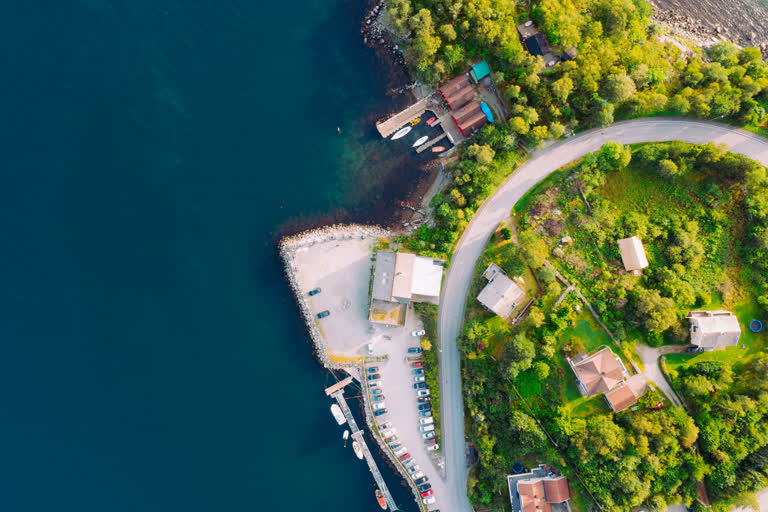Jakarta: Home to more than 10 million people, Jakarta is also one of the fastest sinking cities in the world. Excessive use of groundwater by locals is causing the land to subside much faster than expected along with sea-level rise from climate change.
An upcoming report on oceans and the cryosphere by the Intergovernmental Panel on Climate Change (IPCC) will consider communities like Jakarta as it explores ways to adapt to climate-related changes.
Sea level rise is clearly visible in northern Jakarta.
Jakarta, the sinking city In the last ten years, North Jakarta has sunk by 2.5 metres (8 feet), according to the World Economic Forum.
A half-submerged mosque on the bayside of the wall serves as a stark reminder of what could be in store for the entire area.
A combination of rising sea levels from a heated-up planet and rapid subsidence have compounded the problem.
This swampy ground has been sinking at an average of about 10 centimetres (4 inches) a year.
Lacking a comprehensive piped water network, industry and homeowners have tapped into the city's aquifers leading to subsidence.
Nirwono Joga, an urban planning expert from Trisakti University in Jakarta explained that land subsidence does occur naturally.
"In more than 40 percent of the North Jakarta area, land subsidence actually occurs naturally. But the burden of development including new buildings, ports, industry and road infrastructure for heavy vehicles put additional pressure on the ground's surface. That, plus the unregulated extraction of groundwater is causing land subsidence that would occur slowly and naturally to happen faster."
Indonesia's President Joko Widodo said that he wants the speedy construction of a giant sea wall around Jakarta to prevent the low-lying capital from sinking under the sea.
Widodo and his government are up against a tight timetable, including a forecast by experts that at the current rate, one-third of Jakarta could be submerged by 2050.
"We have to save Jakarta. Actually, the plan to build a giant seawall in North Jakarta already exists so that will be able to save Jakarta from seawater coming from the north. This big project must be done immediately to prevent Jakarta from sinking under the sea," he said.
The threats facing Jakarta is mostly visible in Muara Baru, a poor neighbourhood by the waterfront in the northwest of the city.
Here, a sea wall along the shore is meant to protect the area's makeshift shacks against the waters of the Java Sea.
But the current concrete barrier, raised and reinforced after a major flood more than a decade ago is slowly beginning to show cracks.
"If the settlement still exists when the (new) seawall is built, the government forgets two things; first, the sea level will continue to rise and second, the land surface will go down," explained Joga.
"This means that this seawall will continue to be raised in stages each year which will be a problem because, once the seawall breaks down, the settlement near the beach will sink," Joga added.
Fishing villages and coastal areas of Jakarta which have begun to be submerged in sea water. A steady trickle of seawater leaks through it, covering the street running alongside the wall with a shallow brackish brew and houses are frequently flooded.
As for the future, Joga believes that a forest or a green open space would act as a natural buffer against land subsidence.
"If we change the 500 metres (0.3 miles) area from the north coast and turn it into a forest or a green open space, it will be a natural counterbalance to the abrasion process and also able to reduce excessive use of groundwater by residents at least 500 metres from the coast, so at least there are efforts to stop activities which trigger land subsidence. We prefer this natural buffer rather than having to build a seawall," said Joga.
The $42 billion project envisions three stages, starting with strengthening 30 kilometres (18 miles) of existing coastal dams and creating 17 artificial islands. This would be followed by building giant sea walls on the western and eastern sides of the bay.
Some local fishermen view the project with suspicion, fearing it will rob them of their livelihood.
"If Jakarta sinks, that's a natural risk but if my work is closed (by giant seawall) it will be very difficult for us for a long time," said Pendi, a local fisherman.
Last month, after decades of discussions it was decided that the country's capital will be moved from overcrowded Jakarta to a site in a sparsely populated East Kalimantan province on Borneo island, known for rainforests and orangutans.
In April, Widodo approved a general relocation plan and appealed for support for the move in an annual national address on the eve of Indonesia's independence day August 16.
The new capital city, which has not yet been named, will be in the middle of the vast archipelago nation and already has relatively complete infrastructure because it is near the cities of Balikpapan and Samarinda.
The Intergovernmental Panel on Climate Change (IPCC) will release a Special Report on the Ocean and Cryosphere in a Changing Climate (SROCC) next week on September 25th, 2019.
It will assess the consequences for human communities and also explore options for people to adapt to climate-related changes.
Read also:Sustainable seat art installation brings Londoners together
